
The Super-Predator: How Discourse Shaped Sentencing for Juveniles
The discourse on "super-predator" not only normalized the incarceration of adolescents but also dehumanized the body of color. The action taken by politicians and policymakers in the 90s continues to give people of color a disadvantage. The term "super-predator" preserves the sometimes even subconscious criminalization of their youth.
Super-predator: a history
In the early 1990s, with the increase in juvenile violence, many criminologists and politicians started using the term "super-predator" in the United States. This led to a snowball effect in 45 states that started implementing harsher punishment legislation for juvenile offenses. Thus, allowing to waiver children from juvenile courts and directly in front of adult courts.
In adult courts, the goal is to punish and not rehabilitate; thus, crime verdicts come with minimum sentencing, including life without parole. John DiIulio defines the "super-predator" as kids "who have absolutely no respect for human life and no sense of the future (…) They kill or maim on impulse (…) capable of committing the most heinous acts of physical violence for the most trivial reasons" (DiIulio, 1995). He predicted that by 2010 there would be 270.000 additional "super-predators" roaming the streets.
Various politicians, social scientists, and the media took a radical stance against "super-predators" and the increasing violence from juveniles, therefore supporting the incarceration of teens and children. Their discourse polluted the American perception of children and ingrained fear in its population.
However, DiIulio and criminologists, who supported DiIulio's predictions, were wrong in their theory. As shown in Graph 1, juvenile crime rates started declining by the mid-90s. Nevertheless, the discourses from authority figures and the media stayed, which led to racial discrimination that minorities still feel nowadays.
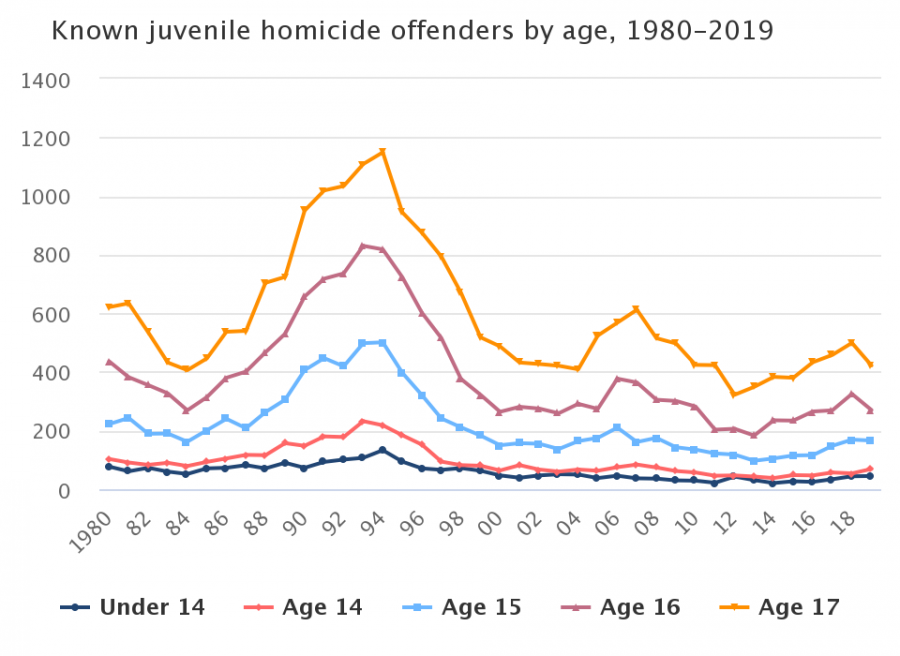
Graph 1: “Known juvenile homicide offenders by age, 1980 - 2019” - Source: Office of Juvenile Justice and Delinquency Prevention/DoJ
In this essay, I will analyze to what extent influential figures in politics and the media had a role in the prosecution of children in the 1990s and their effects in contemporary times. I will focus on a video from Hillary Clinton and the first news article mentioning "super-predators" by John DiIulio and one other media headline at that time. Furthermore, I will study Donald Trump's influence in shaping the media's and peoples' perception of the "Central Park 5" case. Moreover, I will examine if and how political figures backtracked their statements in recent times. Lastly, I will take a closer look at how Donald Trump vilifies his opponents by using the term "super-predator" in his favor.
As a primary analyzing tool, I will use Howard Becker's notion of outsiders (Becker, 1963) and the use of nationalism in their discourses (Billig, 1995) as well as professional vision (Goodwin, 1994).
Hillary Clinton's public use of the term "super-predator"
"Not just gangs of kids anymore. They are the kinds of kids that are called "super-predators"."
On January 25th, 1996, Hillary Clinton gave a speech a Keene State University. She states in a 15-minute long presentation the seven principles of President Bill Clinton's campaign. In a small portion, she mentions that "it is now time for all of us to know what we can do individually to be part of this anti-crime, anti-gangs, anti-drug effort". This shows that those who do not actively participate are not part of their united national effort to root down deviant acts, such as crime, gang violence, and drug use. In these two minutes, Clinton managed to create an "us versus them" mentality (Billig, 1995). The "super-predator" will not conform to their normality and be part of their efforts. Hence, they are no longer part of the American nation and should be treated as "outsiders".
So what does it mean to be an "outsider"? An outsider can be constructed through disobeying societal norms and setting themself apart from established social groups. According to Becker, there is a "common-sense premise that there is something inherently deviant (...) about acts that break (...) social rules" (Becker, 1963). Thus, someone who is considered an outsider is instinctively labeled as deviant. Moreover, it is essential to understand that deviance is created by society. Becker writes "social groups create deviance by making the rules whose infraction constitutes deviance, and by applying those rules to particular people and labeling them as outsiders. (...) deviant behavior is behavior that people so label" (1963).
Clinton uses nationalism (Billig, 1995) to praise the American police forces, citizens, and those participating in neighborhood patrols. She points out that the "progress on this counts as a nation because of what local law enforcement officials are doing, because of what citizens and neighborhood patrols are doing". She gives them credit for the development they have already made since the "Crime Bill" was implemented in 1994. Therefore, she highlights that their efforts are seen and appreciated, which deepens their need to support newly implemented policies to stop "them", meaning those who are deviant and threaten the American norms. Clinton replaces the concept of a nation with concrete societal groups, such as police, citizens and neighborhoods. Thus, Clinton is placing these groups in positions of authority and imprinting on them the notion that they are protecting their nation. Human beings often look for approval, and therefore, these groups are more inclined to take action against outsiders that might stray from their norms.
Clinton talks about seven challenges they, as a nation, have to overcome. The super-predators are thus defined not just as criminals but as a danger to the nation. However, by perpetuating the idea of "super-predators", she isolates an important group from being part of that American nation by designating them as "outsiders" and excluding them from the good, law-abiding society. She connects them to gangs that are affiliated with drug cartels. She is labeling adolescents who fit the narrative as deviant. She spreads the myth that these children maim and kill without second-guessing their actions.
Clinton shows no sympathy towards "super-predators" by minimizing the question as to how these supposed "super-predators" even developed. Thus, she defines them not only as the ultimate other, the deviant, and only breaking the law but also as psychologically different. Moreover, by saying, "we have to bring them to heel", she only prioritizes the policies necessary to stop them.
The mediatization of the "super-predator"
On the other hand, we have the media, always receptive to sensationalized crime news (Sims & Preston, 2006). This led to broader coverage of juvenile crime and, therefore, propagating the ideology of an upcoming rise in young violence and populating the term "super-predator". Thus, through highly selective media presentation, fast legislative changes and juvenile sentencing in adult courts declared a "war" on children (Sims & Preston, 2006, p.176).
Although juvenile homicide rates already declined by 40 percent after hitting a peak in 1994 (Synder, 1998), the "super-predator" kids were still represented as a national crisis. The evening news often depicted violent juvenile crimes from all over the United States. Through their extensive media coverage, legislators felt the need to retaliate by introducing a bill titled the "Violent Youth Predator Act". This bill offered 1.5$ billion in law enforcement grants so states could toughen their laws in cooperation with federal standards and allow 14-year-olds to be tried as adults (Templeton, 1998).
Out of 281 media mentions of the term "super-predator", only two out of five questioned the term's validity (Bogert and Hancock, 2020). According to Bogert and Hancock's analysis, they concluded that less than 40% of newspapers criticized the term. Furthermore, they found the term "super-predator" about 300 times in 40 newspapers ranging from 1995 to 2000. The mediatization of the term, even after juvenile homicides declined, has repercussions that still affect today's youth.
The coming of the super-predators
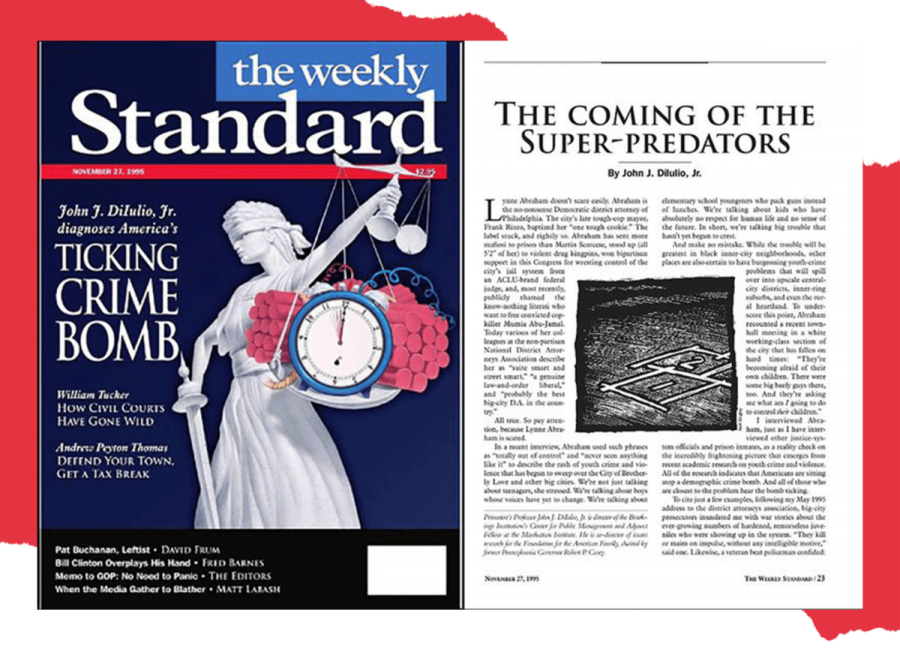
DiIulio, Jr.: “The Coming of the Super-Predators” in the Weekly Standard, November 27, 1995
John DiIulio's article was the first to mention the term super-predator. In the article, he warns of a demographic crime bomb. DiIulio spoke to life-term inmates, who remarked that these kids "are stone-cold predators", which led to the construction of the term "super-predator".
Goàdwin's framework of "professional vision" to create discourse practices to shape certain events is often used by members of a profession of power. In this case, the increased cases of juvenile violence are shaped by then-acclaimed criminologist John DiIulio. Professional vision can be analyzed through three practices: coding, highlighting, and material representation.
DiIulio highlights the time when he went inside juvenile lock-ups, informing the reader that the "buzz of impulsive violence, the vacant stares and smiles, and the remorseless eyes" were too frightening and too depressing even for him.
these kids "are stone-cold predators"
His article already codes to its audience which race of kids they have to look out for, as he points out that between 1985 and 1992, the number of men aged from 14 to 17 that committed murder increased by 300 percent for black people, and only 50 percent for white people. He writes that black assault is likely more violent than non-black assault.
As for material representation, the cover page shows the statute of justice, representing the morality of the justice system. However, on her beam scale is a time bomb, which was often associated which the "super-predator" myth. The cover page conveys the message that the legal justice system is on the verge of "exploding".
Through this discourse, it is easy to see how readers, as well as other media, began to fear these juveniles and label them as deviant (Becker, 1967). We can see that the "super-predator" is a social group associated with deviance by breaking the rules society imposes and, therefore, making them outsiders.
The arrival of super-predators
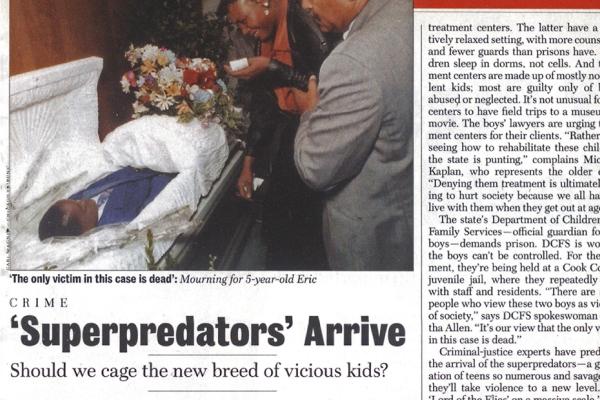
Peter Annin: “'Superpredators’” Arrive: Should we cage the new breed of vicious kids?” In the Newsweek, 21 January 1996
The second headline, "'Super-predators' Arrive: Should we cage the new breed of vicious kids?" was published by Newsweek in 1996. The discourse that Newsweek leads here is dangerous. Their choice of words is closely related to discourse one would use with wild animals. Ben Zimmer, a linguist who studies language and culture, informs that the term "predator" is already full of certain presumptions about how an animal hunts another animal. Thus, declaring kids as "super-predators" really amplifies that even more (2014). So, to also have terms like "breed" and "cage" in the same headline transmit the idea that these kids should not be treated as children but as animals.
Those two headlines were emblematic of the discourse on "super-predators" and constructed reality and policies. The criminalization of the youth of color by the media is not new (Templeton, 1998). Constant use of the term "super-predator" and connecting it to bodies of color left a remaining stereotype of the black population as violent and deviant.
Furthermore, through the "super-predator" epidemic, 45 states allow the publication of an accused juvenile's name, address, and photographs to the general public and media. This had tremendous consequences for these juveniles, as most felt the media affected their trial.
Case Study: Central Park Five sentenced by Donald Trump
On April 19th, 1989, a young woman named Trisha Ellen Meili was assaulted, raped, and left to die while jogging in Central Park in New York. At the same time, a group of 30 teenagers was "wilding" in the same location. The term "wilding" was often connected to youths of color who were behaving violently and as a means to dehumanize and "felon-sizing" their behavior (Mock, 2014). Five teenagers were arrested and found guilty of the crime. Their names are Kevin Richardson, 14, Raymond Santana, 14, Antron McCray, 15, Yusef Salaam, 15, and Korey Wise, 16. They became known as the Central Park Five. Even though none of their DNA matched the semen found at the crime scene, the police could coerce false confessions out of them by putting them through a hard interrogation process for hours.
Even though the five boys took back their confessions, they were all found guilty of offenses including attempted murder, rape, assault, and robbery and were convicted to 5 years to 12 years behind bars. In 2001, the real criminal, Matias Reyes, confessed to attacking Meili, so, in 2002, the Central Park Five were exonerated. They filed a lawsuit against New York City, and the case was settled for $41 million in 2014.
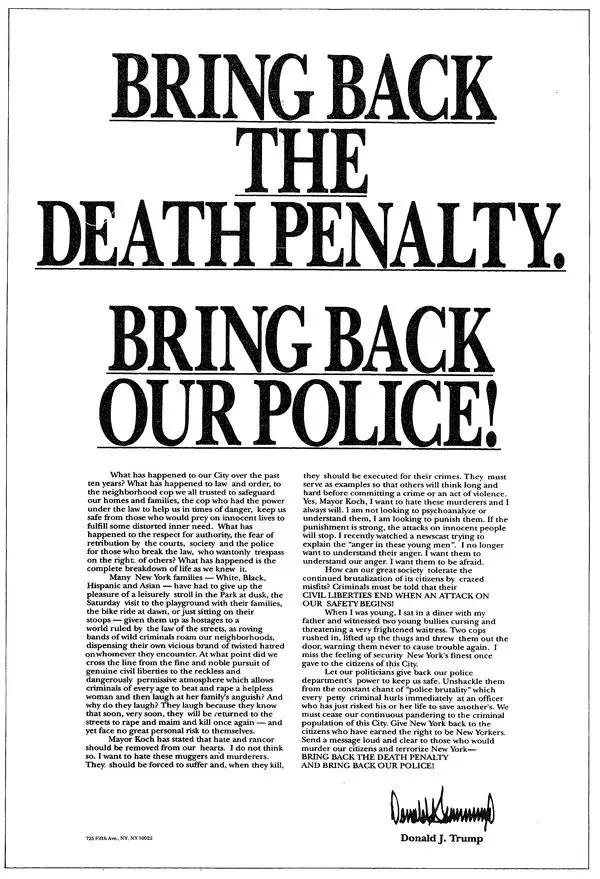
Bring Back The Death Penalty, Bring Back Our Police!
Donald Trump, then a New York property mogul, spent $85,000 to run four full-page adverts to bring back the death penalty after the attack in Central Park happened. The ad was titled "Bring Back The Death Penalty, Bring Back Our Police!". In the advert, he already signals the impression that these five boys are guilty, because who would pay such an amount of money to spread lies, right?
"I want to hate the muggers and murderers. They should be forced to suffer and, when they kill, they should be executed for their crimes."
Furthermore, in the ad, he talks about how he "want(s) to hate the muggers and murderers. They should be forced to suffer and, when they kill, they should be executed for their crimes." Trump highlights multiple times that he is in favor of the death penalty.
In an interview with Larry King in 1989 for CNN, King says that the ad seemed insightful, vigilant and gave the message to fight back. Hence, we can assume that the overall reactions to the ads from citizens were positive. Trump later points out that from over 15,000 letters, which came after his ads' publication, allegedly only "two or three that were negative". Thus, announcing that so many people endorse his statements creates a social group that people feel obliged to belong to because otherwise, you stand with the criminals.
We see that Trump's condemnation of these five young boys used multiple media practices to convince the public of their guilt. Firstly, Trump managed to reach many newspaper readers with his ad. Furthermore, he tries to manipulate the reader by appealing to their emotion, in this instance, fear and frustration, highlighting where society changed from "the fine and noble pursuit of genuine civil liberties to the reckless and dangerously permissive atmosphere which allows criminals of every age to beat and rape". Secondly, the interview with Larry King reaches an even broader audience that might share Trump's view. It is crucial to understand that all these media practices where he publicly sentences them to death happened before the Central Park Five even stood in court. Through the ads, the interview, and mentioning the ads' reception, he discursively created a group of people who see themselves as vigilantes and singlehandedly will protect their families and friends against deviant outsiders.
Even though Trump did not use the term "super-predator" in his public condemnation of these youths, it was a reinforcement of the stereotype of the animalistic, inherently criminal black male. Trump referred to them as "savages". People felt even more comfortable with lynching mob rhetoric with Trump's ads. To elucidate, politician and journalist, Pat Buchanan called for a public hanging in Central Park and many more followed in their public denunciation of the Central Park Five. Thus, it contributed to the already existing racial tensions in the United States.
“The super-predator" myth in the social media age
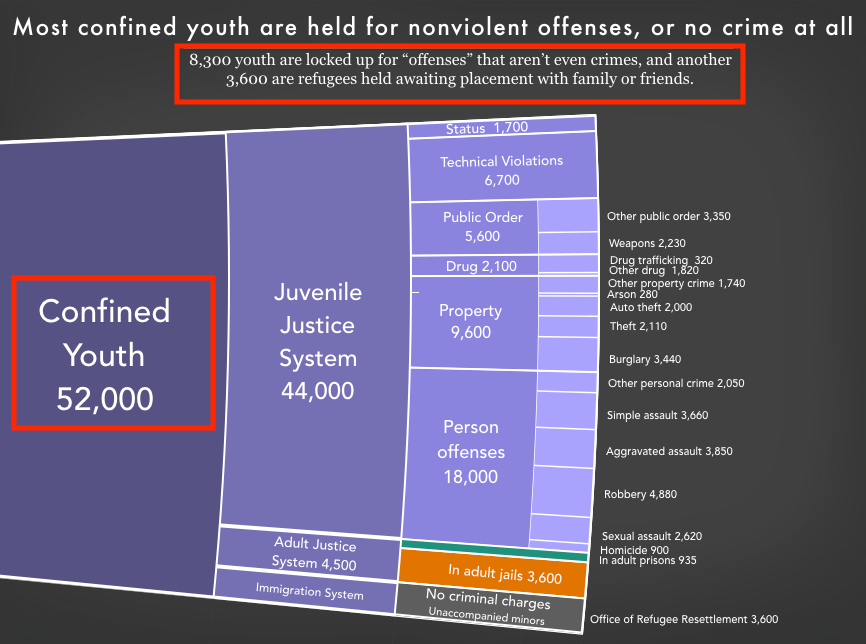
Youth Confinement, March 2020
By the end of the 90s, the public was already able to see that DiIulio's prediction fell flat. The juvenile crime rates were low, and the "super-predator" myth was debunked. However, their impact on criminal law in communities of minorities is still intact. The United States is the leading country in incarcerating juveniles. By March 2020, about 52,000 kids were held in confined facilities. Most of them are locked up for offenses that are not even crimes, such as technical violations of their probation, running away, absence at school, and incorrigibility (Sawyer and Wagner, 2020).
Nowadays, the internet does not forget, and forgiveness is even less likely. Hillary Clinton and John DiIulio, issued each a different kind of apology for their contribution to increased juvenile crime incarceration. Alternatively, Donald Trump did not issue one at all.
"You're the first person to ask me. And I'm happy to address it"
First, we have a clip of Hillary Clinton from CNN from 2016. She was confronted with criticism during her 2016 Democratic presidential primaries, for her support of the crime bill in the 90s and her use of the term "super-predator". During a private fundraiser in February 2016, two Black Lives Matter activists interrupted a presenting Hillary Clinton and demanded an apology for her statements in 1996. Hillary responded by saying, "You're the first person to ask me. And I'm happy to address it", but from the video, she seems displeased about the interruption.
Nevertheless, the following day she released a statement saying, "I shouldn't have used those words, and I wouldn't use them today". Clinton continues that her life's work has been about lifting those who have been failed by the system, "kids who never got the chance they deserved (…) We haven't done right by them. We need to".
In this second clip, we have John Dilulio, the criminologist whose theory caused the "super-predator" epidemic. He acknowledges that his predictions were wrong, but by the time they could prove it, the term "super-predator" was already a part of the lexicon (DiIulio, 1996) and the word had, "sort of gotten out and gotten away from me." Unfortunately, the fear of "the super-predator" caused new policies and laws that the United States is still recovering from (Krisberg, 2014).
"sort of gotten out and gotten away from me."
However, DiIulio owns up to his mistake and actively participates in the fight to rectify what the "super-predator" myth has caused to minorities.
In 2012, the supreme court document "Kuntrell v. Hobbs, No. 10-9647", which would ban mandatory life sentencing for juveniles convicted of murder, was also signed by DiIulio as it "came to the right conclusion". DiIulio continues to implement positive change, as he has worked with three White House administrations to execute faith-based initiatives in underprivileged communities.
In this third clip, we can see that former President Trump feels no remorse for his ad in 1989. "You have people on both sides of that. They have admitted their guilt (…) We will leave it at that". By that, former President Donal Trump dismisses the interviewer's initial question. It shows that even though the Central Park Five were all exonerated by 2002, the actual offender, Matias Reyes, confessed to the crime with matching DNA evidence. He is still unable to say that he was wrong and that publishing that ad was also wrong.
Trump's ploy to villainize his opponents
Trump has repeatedly abused the term "super-predator" to vilify his opponents in an attempt to turn away their black voters in both presidential campaigns in 2016 and 2020.
In 2016, Donald Trump and Hillary Clinton were running for president of the United States of America. During Trump's campaign, he consistently used Hillary's past comment on the term "super-predator" in his favor. Tweets, posts, and campaign movies were published to gain more African American voters.
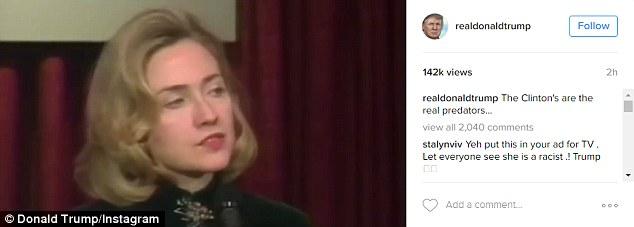
The Clinton's are the real predators...
In 2020, Trump again used "super-predator" to villainize his opponent, Joe Biden. In a series of tweets, Trump says that Biden used and is still using the term "super-predator" to identify black youths. However, it is nowhere publicly recorded that Joe Biden used the word "super-predator". Conversely, Biden pushed in favor of the "Crime Bill", leading to massive incarceration numbers in black and brown communities. Nonetheless, Trump lied to strengthen his position in the 2020 election.
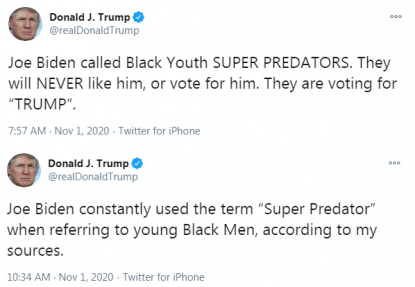
In their first presidential debate, Trump was quick to say, "Look at the crime bill, 1994, where you called them 'super-predators,' African Americans are 'super-predators'. (...) And they've never forgotten that." This is not the truth as Hillary Clinton used the term in a public speech, as we have seen in this paper.
To this end, we can see that the term "super-predator" is still in circulation, and therefore, racial profiling, as people connect it to black and brown youths. Yet, Trump's attempts to vilify his opponents by throwing around their use of the "super-predator" myth, or lack thereof in Biden's case, often fell flat. His supporters continue to stand behind him no matter what lies he tells, but he did not gain many followers through these actions.
Conclusion
To conclude, this article has shown that what public figures say and do can lead to severe consequences. Their use of professional vision (Goodwin, 1994) in their discourses immediately invalidates the other parties' explanations and shapes the events to their liking.
Furthermore, we see more and more evidence of racial profiling on social media. Police are called for even non-violent situations which often escalate, such as the brutal murders of Trayvon Martin in February 2012, and more, recently George Floyd in May 2020. Unwarranted use of violence and racial discrimination is dividing the United States even more.
The issue of racism in the United States is no secret. Through our analysis, we can affirm that the discourse on the "super-predator" myth in the 1990s partially caused the dehumanization of the body of color and criminalization of juvenile behavior. Politicians and lawmakers' fast reaction by applying and enforcing new laws to lock up mostly non-white youths still apply currently.
References
Annin, P. (1996, 01 21). 'Superpredators' Arrive. Newsweek.com.
BBC News. (2019). Central Park Five: The true story behind When They See Us. BBC.com.
DiIulio, J. (1999). THE COMING OF THE SUPER -- PREDATORS. The weekly standard.
Goodwin, C. (1994). Professional Vision (96th ed., Vol. 3). American Anthropologist.
Heather and Little. (n.d.). The Meaning Behind the Lady of Justice Statue. heatherandlittle.com.
Known juvenile homicide offenders by age, 1980-2019. (2020). OJJDP Statistical Briefing Book.
Le Claire, M. M. (2016). The Use Of The Term “Superpredator”: History And Application. huffiest.com.
Mock, B. (2014). How our fear of “wilding” colored the Central Park Five case. grist.org.
Pierce, S. D. (2013). PBS film delivers justice for the Central Park Five. The Salt Lake Tribune.
Savransky, R. (2016, October 20). Trump ad knocks Clinton over “superpredator” remark. TheHill.
Sawyer, W., & Wagner, P. (2020, March). Mass Incarceration: The Whole Pie 2020. prisonpolicy.org.
Scott, E. (2016, February). Black Lives Matter protesters confront Clinton at a fundraiser. CNN.com.
Sims, B., & Preston, P. (2006). Handbook of Juvenile Justice: Theory and Practice Public Administration and Public Policy. CRC Press.
Templeton, R. (1998, 01 01). Superscapegoating. Fair.org.
UKEssays. (2018, November). Howard Becker Studies in the Sociology of Deviance.